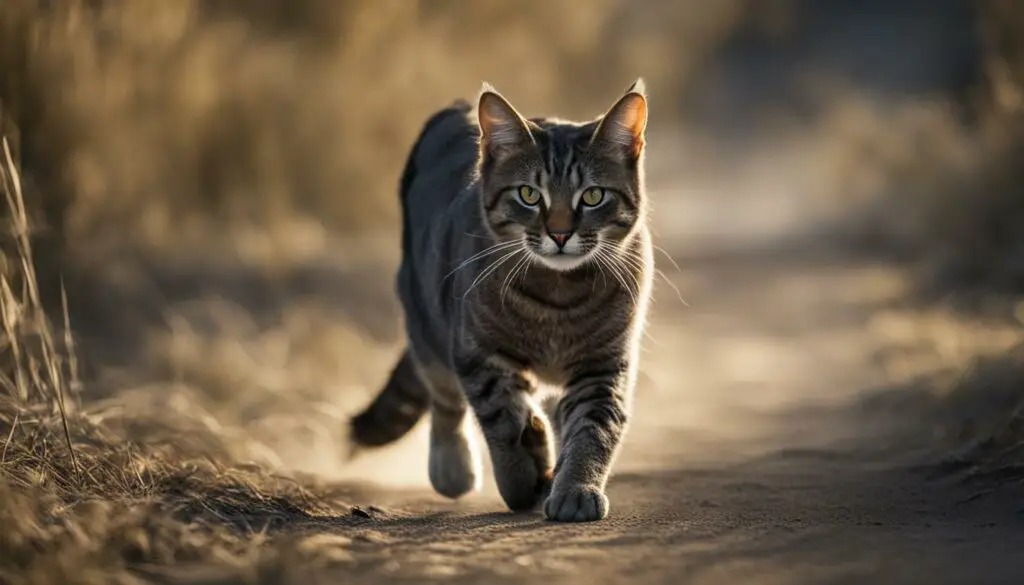As a cat lover and enthusiast, I’ve often wondered about the mysteries surrounding male cat behavior. One particular question that frequently comes up is whether male cats experience arousal and sexual drive. In this article, we’ll delve into the fascinating world of male cat sexual behavior, exploring their reproductive instincts, mating behaviors, and yes, the topic of whether they get horny or not.
When it comes to male cats, their sexual behavior can be influenced by various factors, including their hormonal fluctuations, grooming sessions, health conditions, and even the presence of catnip. Understanding these factors can help us better comprehend and address any concerns related to male cat arousal.
So, let’s embark on this enlightening journey, unraveling the intricacies of male cat behavior and shedding light on their mysterious mating instincts.
Key Takeaways:
- Male cats can experience arousal and display sexual behavior.
- Factors such as grooming sessions, health conditions, hormonal fluctuations, and catnip play a role in male cat arousal.
- Neutering can significantly reduce sexual behaviors in male cats.
- Understanding feline body language and setting boundaries is essential during petting sessions.
- Creating a nurturing and soothing environment enhances the bond between cats and their owners.
Reasons Behind Male Cat Arousal
Male cat arousal can be influenced by various factors. One of the primary reasons for their arousal is the pleasure they experience from attention and petting. Just like humans, cats enjoy physical touch and affection, and it can stimulate their sexual behavior. Even neutered male cats may still display arousal behaviors, particularly if they were intact or neutered later in life. Grooming sessions can also lead to penile exposure, which is a normal occurrence for male cats. However, if a cat frequently has erections, it could indicate underlying health conditions or the presence of debris in the genital area.
Hormonal fluctuations can also contribute to male cat arousal. During puberty, male cats experience changes in their hormone levels, making them more energetic and prone to sporadic arousal. Additionally, the consumption of catnip can have a stimulating effect on male cats, leading to increased arousal during petting sessions.
Reasons Behind Male Cat Arousal
One of the main reasons for male cat arousal is the pleasure they derive from attention and petting. Neutered male cats may still exhibit arousal behaviors, especially if they were intact or neutered later in life. Grooming sessions can also lead to penile exposure, which is considered normal for male cats. However, frequent erections could indicate underlying health conditions or the presence of debris in the genital area. Hormonal fluctuations during puberty and the consumption of catnip can also contribute to male cat arousal.
Health Conditions and Male Cat Arousal
When it comes to male cat arousal, it’s important to consider the role of health conditions. Frequent erections in male cats can be a sign of urinary tract infections or urinary stones. These conditions can cause discomfort, leading to increased sensitivity in the genital area and subsequent arousal. Additionally, more severe cases of frequent erections may indicate underlying neurological problems. If your male cat consistently displays arousal behaviors and constantly cleans the area, it may be necessary to seek veterinary assistance to clear out any debris or address any potential health concerns.
Monitoring your cat’s arousal behaviors and addressing any health issues promptly is essential for their overall well-being. Regular check-ups with a veterinarian can help identify and treat any underlying conditions that may be causing the frequent erections. It’s crucial to provide the necessary care and attention to ensure your male cat remains happy and healthy.
Table: Common Health Conditions and Male Cat Arousal
| Health Condition | Description |
|---|---|
| Urinary Tract Infections | Can cause increased sensitivity in the genital area, leading to frequent erections |
| Urinary Stones | Can cause discomfort and sensitivity, resulting in frequent erections |
| Neurological Problems | More severe cases of frequent erections may indicate underlying neurological issues |
Understanding and addressing health conditions that may contribute to male cat arousal is crucial for providing proper care and ensuring the well-being of your feline companion. By staying vigilant and seeking veterinary assistance when necessary, you can help maintain a healthy and comfortable life for your male cat.
The Role of Neutering in Male Cat Arousal
Neutering plays a significant role in reducing male cat arousal and unwanted sexual behaviors. While intact male cats are more likely to display frequent erections and engage in mating behaviors, neutering helps decrease the production of testosterone, the hormone responsible for driving sexual arousal in cats. However, it’s important to note that the timing of neutering can impact its effectiveness in curbing male cat arousal.
Male cats that are neutered before reaching sexual maturity, typically around six months of age, are less likely to exhibit persistent arousal behaviors. This is because early neutering prevents the development of strong mating instincts and reduces the production of testosterone. On the other hand, male cats that are neutered later in life, especially if they have already engaged in mating encounters, may continue to display arousal behaviors even after the procedure. This is because the behavior patterns associated with sexual arousal may have become ingrained.
The Benefits of Early Neutering
Early neutering not only helps prevent unwanted sexual behaviors but also contributes to overall positive male cat behavior. Neutered male cats are less likely to roam, engage in territorial disputes, and display aggressive mating behaviors such as spraying urine to mark their territory. By reducing the production of testosterone, early neutering promotes a calmer and more content demeanor in male cats, leading to a happier and healthier feline companion.
The Importance of Veterinary Advice
When considering neutering as a means to reduce male cat arousal, it’s crucial to consult with a veterinarian. They can provide expert guidance on the best time to neuter your male cat based on their individual circumstances and behavior patterns. Neutering is a safe and routine procedure, but it should always be performed by a qualified veterinarian to ensure the well-being of your furry friend.
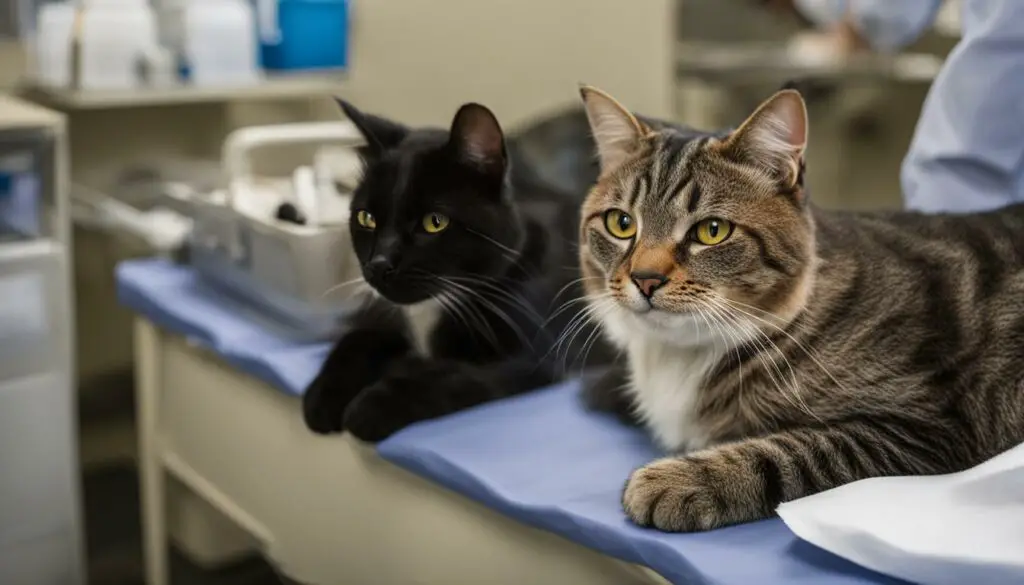
The Influence of Hormonal Fluctuations
Hormonal fluctuations play a significant role in male cat arousal and sexual behavior. Just like human adolescents, male cats experience hormonal changes during puberty, which can make them more energetic and prone to sporadic arousal. These fluctuations are a natural part of feline development and should be considered when assessing a male cat’s sexual behavior.
During puberty, male cats go through a surge of hormones, including testosterone, which can influence their behavior and sexual drive. This hormonal shift can lead to increased sexual behaviors, such as mounting or excessive vocalization. It is important for cat owners to understand that these behaviors are temporary and will subside as the cat matures.
In addition to puberty, hormonal fluctuations in male cats can also be influenced by factors such as stress, environmental changes, and the presence of female cats in heat nearby. These external factors can trigger hormonal responses in male cats, leading to temporary arousal and sexual behaviors.
Hormonal Fluctuations and Behavior Management
Understanding the influence of hormonal fluctuations on male cat arousal can help owners manage their cat’s behavior effectively. By providing a calm and stable environment, minimizing stressors, and ensuring regular play and exercise, owners can help alleviate the impact of hormonal fluctuations on their male cat’s behavior.
It is also important to remember that neutering can significantly reduce unwanted sexual behaviors in male cats by decreasing testosterone levels. Neutering is recommended for all male cats unless they are intended for breeding purposes. It not only helps manage arousal behaviors but also contributes to overall positive behavior and prevents territorial marking.
| Hormonal Fluctuations and Male Cat Arousal | Management Tips |
|---|---|
| Hormonal fluctuations during puberty can lead to increased sexual behaviors in male cats. | Provide a calm and stable environment. |
| External factors, such as stress and changes in the environment, can trigger hormonal responses. | Minimize stressors and maintain routine. |
| Neutering significantly reduces testosterone levels and helps manage arousal behaviors. | Consider neutering unless breeding is intended. |
By understanding and addressing the influence of hormonal fluctuations on male cat arousal, owners can create a harmonious and comfortable environment for their feline companions, ensuring both their well-being and the strength of the bond between cat and owner.
Effects of Catnip on Male Cat Arousal
When it comes to male cat arousal, an intriguing factor to consider is the effect of catnip. Catnip, also known as Nepeta cataria, is a herb that belongs to the mint family. Many cat owners have noticed that after consuming catnip, their feline companions exhibit heightened excitement and sometimes even erections. This reaction is considered normal and should not be a cause for concern.
Catnip contains a chemical compound called nepetalactone, which acts as a stimulant for cats. When a male cat sniffs or ingests catnip, it triggers a response in the cat’s brain, causing a release of feel-good chemicals. This euphoric response can lead to increased energy and arousal during petting sessions.
It’s worth noting that not all cats are affected by catnip. Sensitivity to catnip is hereditary and is estimated to affect around 50-75% of adult cats. Kittens under six months old are generally not affected by catnip until they reach sexual maturity. However, it’s important to remember that catnip is safe for cats and can provide them with mental and physical stimulation.
“Catnip can be a fantastic tool for enriching your cat’s environment and providing them with a source of stimulation. Just keep in mind that not all cats will react to it, and their responses can vary from mild to intense.” – Dr. Emily Thompson, Veterinary Behaviorist
The Catnip Response
The response to catnip can vary between cats. Some may become more playful, rolling on their backs and rubbing their bodies against the source of catnip. Others may display increased affection towards their owners, seeking more contact and attention. In some cases, male cats may exhibit erections or other signs of sexual arousal after consuming catnip.
It’s important to remember that the arousal caused by catnip is temporary and does not indicate a persistent and concerning issue. If your male cat displays arousal behaviors after consuming catnip, it is simply a natural response to the chemical compounds in the herb. As the effects of catnip wear off, your cat will return to their usual behavior.
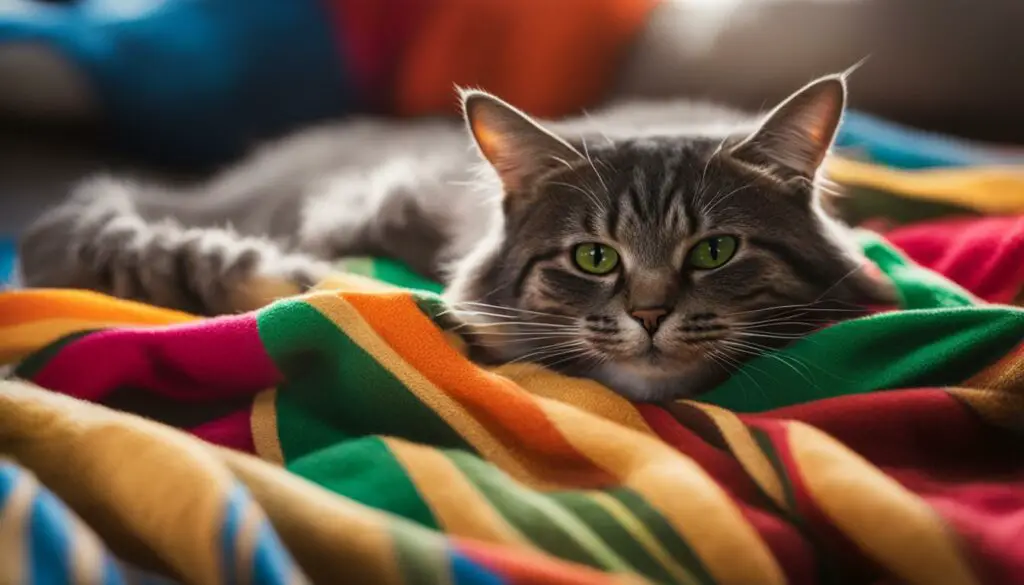
In conclusion, catnip can have a stimulating effect on male cats, sometimes leading to arousal behaviors such as erections. This response is normal and not a cause for worry. Catnip can provide mental and physical stimulation for cats, enhancing their overall well-being. However, not all cats will react to catnip, and individual responses can vary. As responsible cat owners, it’s essential to provide a safe and enriching environment for our feline companions, and incorporating catnip can be one way to achieve that.
Tips for Managing and Enhancing Petting Sessions
Petting sessions are a wonderful way to bond with your feline companion and provide them with the love and attention they crave. However, it’s essential to approach these sessions with sensitivity and respect for your cat’s boundaries. Here are some tips to help you make the most out of your petting sessions and ensure a positive experience for both you and your furry friend.
Observing Body Language
Understanding your cat’s body language is crucial in ensuring a comfortable and enjoyable petting session. Look for signs of relaxation and contentment, such as purring, closed eyes, and a relaxed body posture. On the other hand, if your cat starts to tense up, flick their tail, or move away from you, it’s a clear indication that they have had enough petting and need some space. Respecting their signals will help maintain trust and prevent any potential discomfort during the session.
Creating a Soothing Environment
Setting the right ambiance can significantly contribute to the success of a petting session. Find a quiet and comfortable location where your cat feels safe and secure. Eliminate any potential distractions, such as noise or other pets. Consider using soft lighting and playing calming music to create a peaceful atmosphere. Remember, a relaxed environment enhances the overall experience for both you and your cat.
“Understanding your cat’s body language is crucial in ensuring a comfortable and enjoyable petting session.”
Incorporating Play and Rewards
Integrating play into your petting sessions can be a great way to engage your cat and enhance their enjoyment. Use interactive toys, such as feather wands or laser pointers, to stimulate your cat’s natural hunting instincts. Alternate between play sessions and gentle petting to keep the experience varied and exciting. Additionally, offering treats and rewards during and after the session can reinforce positive behavior and further strengthen your bond with your cat.
By following these tips and being mindful of your cat’s preferences, you can create a harmonious and fulfilling petting session that nurtures your relationship and brings joy to both you and your feline companion.
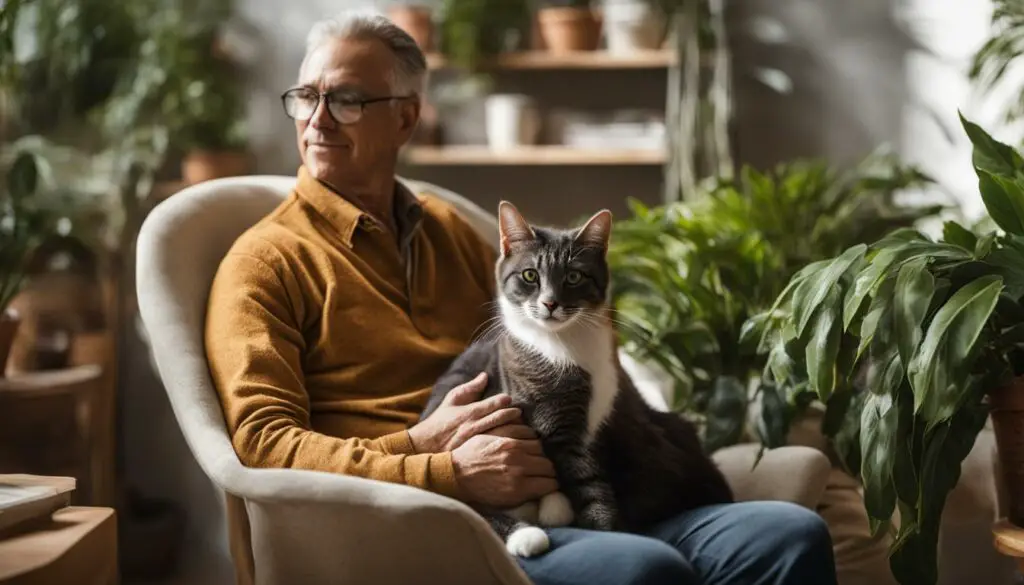
Table: Understanding Cat Body Language
| Body Language | Meaning |
|---|---|
| Purring | Contentment and relaxation |
| Slow blinking | Trust and affection |
| Tail held high | Confidence and friendliness |
| Tail flicking | Agitation or overstimulation |
| Flattened ears | Fear or aggression |
| Hissing or growling | Defensive or threatened |
The Importance of Neutering in Male Cat Behavior
Neutering male cats not only helps reduce unwanted sexual behaviors but also contributes to overall positive behavior. Neutered male cats are less likely to roam, engage in territorial disputes, or display aggressive mating behaviors. It is recommended to have male cats neutered by the age of six months to prevent these behaviors.
Neutering significantly reduces testosterone levels in male cats, making them less prone to exhibit sexual arousal and aggression. Without the influence of reproductive hormones, neutered males are generally calmer and more docile. They are less likely to engage in destructive behaviors such as urine marking or fighting over mates. By neutering male cats at an early age, owners can help shape their behavior in a positive manner, promoting a harmonious living environment.
A study conducted by the American Veterinary Medical Association found that neutering male cats has numerous health benefits as well. It reduces the risk of testicular cancer and lowers the chances of developing prostate problems later in life. Furthermore, neutered cats are less likely to contract urinary tract infections or be involved in catfights, minimizing the risk of contracting infectious diseases. By taking this proactive step, owners can safeguard the well-being of their male feline companions.
The Challenges of Neutering in Male Cat Behavior
Neutering male cats is highly beneficial for curbing unwanted behaviors and promoting a more positive overall behavior. However, it is important to note that in some cases, neutering may not completely eliminate certain behaviors in male cats. Approximately 10% of neutered male cats may continue to display sexual behaviors and exhibit urine spraying as a means of marking territory.
The persistence of these behaviors can be attributed to various factors. For some male cats, the behavior may have become ingrained before they were neutered, especially if they were neutered later in life. The influence of previous mating encounters and the surge of hormones during puberty can also contribute to lingering sexual behaviors in neutered male cats.
To address these challenges, owners should be proactive in managing and modifying their cat’s behavior. Providing environmental enrichment, such as interactive toys, scratching posts, and vertical spaces, can help redirect the cat’s energy and prevent boredom. Along with consistent training and positive reinforcement, behavioral modification techniques can be utilized to discourage sexual behaviors and urine spraying. In cases where the behaviors persist and significantly impact the cat’s quality of life, consulting with a veterinarian or an animal behaviorist may be necessary to explore additional interventions or medication options.
Medication Options for Sexually Aggressive Cats
When dealing with sexually aggressive behavior in male cats, medication can be a viable option to help curb these behaviors. It’s important to note that medication should only be used under the careful supervision of a veterinarian. Two commonly prescribed medications for sexually aggressive cats are clomipramine and fluoxetine.
Clomipramine: Clomipramine is an antidepressant medication that also has anti-anxiety properties. It works by increasing levels of serotonin in the brain, which helps to regulate mood and behavior. This medication can be effective in reducing sexually aggressive behaviors in male cats, but it may take several weeks to see noticeable improvements.
Fluoxetine: Fluoxetine, also known as Prozac, is another medication that can be used to treat sexually aggressive behavior in cats. It belongs to a class of antidepressant medications called selective serotonin reuptake inhibitors (SSRIs). Like clomipramine, fluoxetine works by increasing serotonin levels in the brain. It can help reduce aggression and calm the cat, but it may also take some time to see positive results.
Considerations and Side Effects
It’s important to keep in mind that medication should not be the sole solution for addressing sexually aggressive behavior in cats. Behavioral modification techniques, environmental enrichment, and other interventions should also be implemented to help manage and modify the behavior. Additionally, medication should always be used in conjunction with regular veterinary care and monitoring.
Both clomipramine and fluoxetine can have potential side effects, and these should be carefully considered and discussed with a veterinarian. Common side effects may include drowsiness, loss of appetite, gastrointestinal upset, and changes in behavior. It is important to closely monitor the cat during medication use and report any concerning side effects to the veterinarian.
Conclusion
Medication can be a valuable tool in managing sexually aggressive behaviors in male cats. However, it should be used as part of a comprehensive approach that includes behavioral modification techniques and environmental enrichment. Always consult with a veterinarian to determine the most appropriate course of action for your cat’s individual needs.
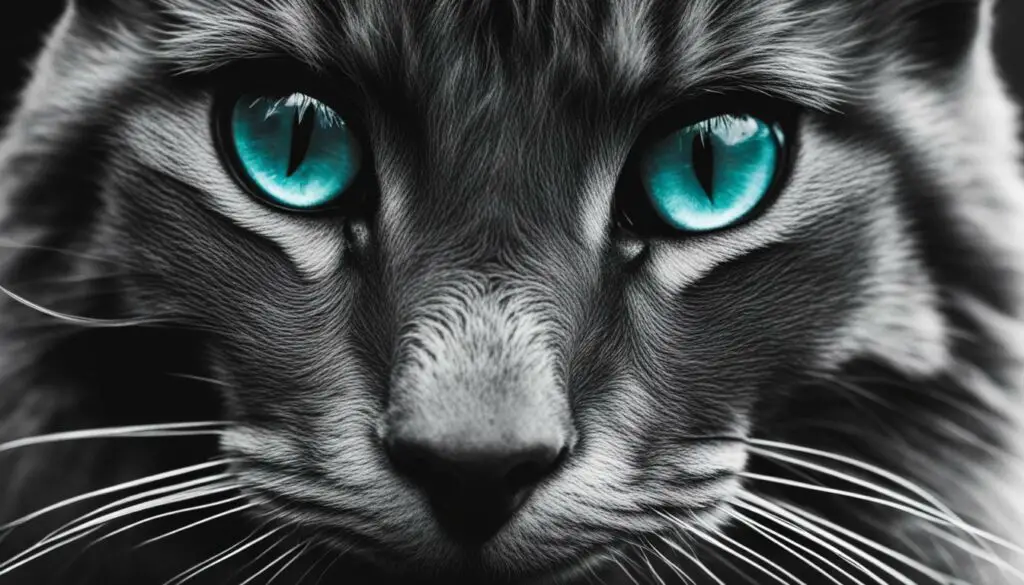
Bonding between Cats and Owners
The bond between cats and their owners is truly special. As a cat aficionado, I can attest to the strong connection that can develop between felines and their human companions. Cats see us as their social partners, relying on us for more than just food and shelter.
In fact, studies have shown that women tend to interact more with their cats, and female owners often have more intense relationships with their feline companions. Cats remember kindness and may even return the favor through their behavior. Their loyalty and affection can make them feel like furry children in our nurturing homes.
To foster a deeper bond with your cat, it’s important to understand their individual preferences and needs. Creating a soothing and welcoming environment is key. Additionally, finding activities that both you and your cat enjoy, such as playtime or grooming sessions, can strengthen your connection.
The cat-owner bond is a beautiful and mutually beneficial relationship. Cats provide companionship, emotional support, and even stress relief, while we provide love, care, and a safe home. By nurturing this bond and understanding our cats on a deeper level, we can truly enhance our lives and the lives of our beloved feline friends.
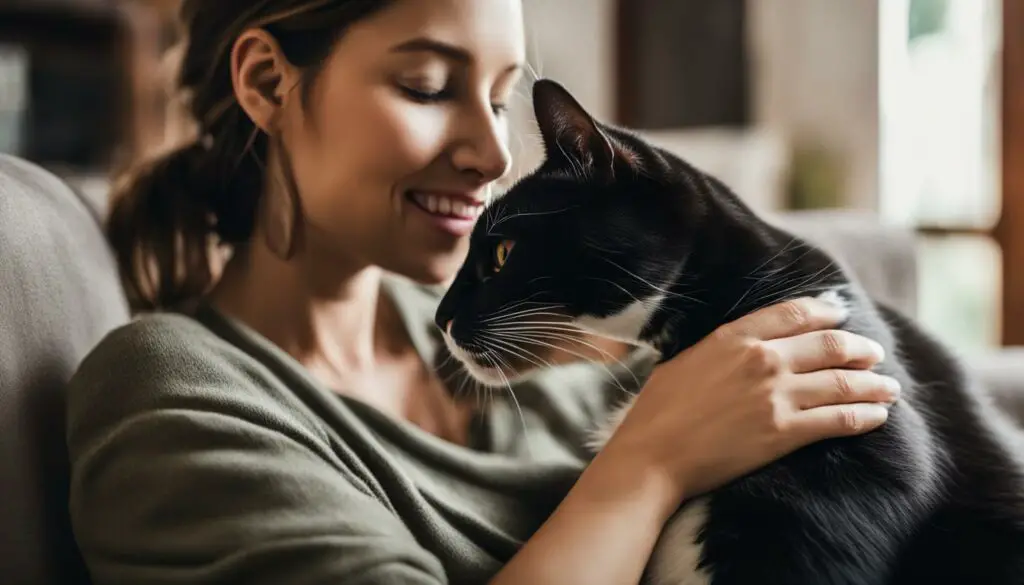
Table: Factors Influencing Cat-Owner Relationships
| Factors | Influence |
|---|---|
| Age | Cats may bond differently with owners of different age groups |
| Sex | Women tend to have more intense relationships with their cats |
| Personality | Cats may connect better with owners who have similar personality traits |
Factors Influencing Cat-Owner Relationships
When it comes to the bond between cats and their owners, various factors play a role in shaping the intensity and quality of their relationship. One significant factor is the age, sex, and personality of the owner. Studies have shown that female owners tend to interact more with their cats and often have more intense relationships with their feline companions.
“Cats are highly attuned to human emotions and can form strong emotional connections with their owners, especially when they perceive kindness and care,” says Dr. Jane Carter, a renowned feline behaviorist. She explains that cats remember positive experiences and may actively seek out their owners for companionship and affection.
Additionally, the level of interaction and engagement between the owner and the cat can also influence their relationship. Cats thrive on attention and play, so regularly engaging in interactive play sessions and providing mental stimulation can strengthen the bond between owner and feline.
Understanding the Unique Preferences of Cats
Each cat is an individual with their own preferences, likes, and dislikes. Understanding and respecting these unique qualities are essential for fostering a strong cat-owner relationship. Some cats may enjoy being held and cuddled, while others may prefer gentle strokes and the freedom to roam. By observing a cat’s body language and responding accordingly, owners can ensure that their feline friends feel respected and comfortable.
“Cats communicate through subtle cues, such as tail flicks, ear positions, and vocalizations,” says Dr. Carter. “By paying attention to these signals, owners can better understand their cats’ needs and provide the appropriate level of interaction.”
The investment of time and effort in building a strong bond with a cat is mutually beneficial. Cats offer companionship, emotional support, and entertainment to their owners, while owners provide love, care, and a nurturing environment. The cat-owner bond is a unique relationship that can bring immense joy and fulfillment to both parties involved.
Benefits and Complexities of Cat-Owner Relationships
The bond between cats and their owners goes beyond providing food and shelter. It is a unique relationship that offers a multitude of benefits and complexities. Cats see their owners as social partners and rely on them for companionship, affection, and support. In return, cats bring joy, comfort, and entertainment to the lives of their human counterparts. Let’s explore the numerous facets of cat-owner relationships and the positive impact they have on both parties.
One of the key benefits of cat ownership is the emotional bond that develops between cats and their owners. This bond is built on mutual attraction and trust, with cats often treating their owners as family members. The affection shared between a cat and its owner provides a sense of companionship and reduces feelings of loneliness or isolation. This emotional connection has been shown to improve mental well-being, reduce stress levels, and even lower blood pressure.
In addition to the emotional benefits, cat ownership also offers practical advantages. Cats are known for their independent nature, making them suitable pets for individuals with busy lifestyles. They require less attention and maintenance compared to other pets, such as dogs. Cats are also adept at providing entertainment through their playful antics, which can bring joy and laughter into the home.
| Benefits of Cat Ownership | Complexities of Cat Ownership |
|---|---|
|
|
“The emotional bond between cats and their owners provides a sense of companionship and reduces feelings of loneliness or isolation.”
Complexities of Cat Ownership
While cat ownership brings many benefits, it also comes with its own complexities. Being a responsible cat owner involves ensuring their well-being through proper care and nutrition. This includes providing a balanced diet, regular veterinary check-ups, and vaccinations. Additionally, owners may need to address behavioral issues, such as scratching furniture or aggression, through training and environmental enrichment.
Health concerns are another aspect that cat owners must be prepared to manage. This includes monitoring their cat’s weight, dental health, and grooming needs. Regular cleaning of the litter box is essential to maintain hygiene and prevent litter box aversion. In cases of extended absence, arranging for pet care or finding a reliable pet sitter becomes crucial.
While there are complexities to cat ownership, the joy, companionship, and rewards that come with nurturing a happy and healthy feline companion far outweigh the challenges. By providing love, care, and a nurturing environment, cat owners can forge a lifelong connection with their beloved pets.
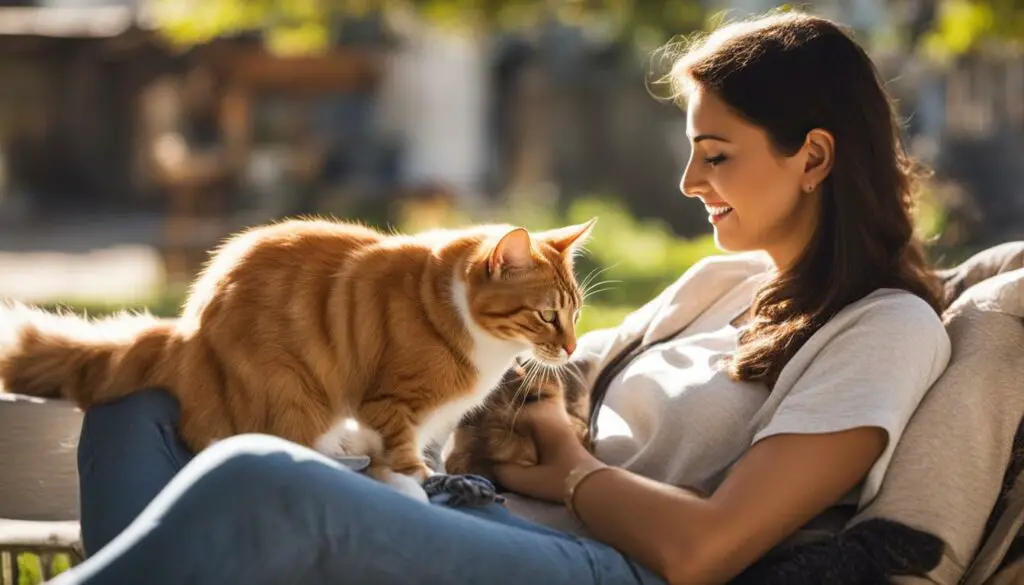
Conclusion
Understanding cat behavior during petting sessions is crucial for building a strong bond between cats and their owners. By recognizing their boundaries, observing their cues, and creating a soothing environment, we can enhance the pleasure of these interactions. Each cat is unique, so it’s important to tailor our petting techniques to their individual preferences.
The cat-owner bond is a special relationship that offers mutual attraction, compatibility, play, affection, and social support. Cats see their owners as social partners and rely on them for more than just food. By nurturing these relationships, we become part of an enchanting world where cats become our furry “children” in nurturing homes.
Throughout our interactions, it’s crucial to remember that cats remember kindness and may express their gratitude through their behavior. By embracing the fascinating world of feline behavior and understanding the complexities of cat-owner relationships, we can foster a deeper connection and mutual love between our feline companions and ourselves.
FAQ
Do male cats get horny?
Yes, male cats can experience arousal and display sexual behavior, especially if they are intact or were neutered later in life.
What are the reasons behind male cat arousal?
Male cats can become aroused due to factors such as grooming sessions, possible health conditions, presence of debris, hormonal fluctuations, and the effect of catnip.
Can health conditions contribute to male cat arousal?
Yes, frequent erections in male cats could be a sign of urinary tract infections or urinary stones, and more severe cases could indicate neurological problems.
What is the role of neutering in male cat arousal?
Neutering significantly reduces testosterone levels in male cats, making erections less common. However, male cats that were neutered later in life may continue to exhibit arousal behaviors.
How do hormonal fluctuations affect male cat arousal?
Hormonal fluctuations during puberty can make male cats more energetic and prone to sporadic arousal.
What effects does catnip have on male cat arousal?
Some male cats may exhibit erections after consuming catnip, as the euphoria caused by catnip can lead to arousal during petting sessions.
What are some tips for managing and enhancing petting sessions?
Observing a cat’s body language, setting boundaries, creating a soothing environment, incorporating play, using gentle and consistent strokes, and offering treats and rewards can enhance petting sessions.
What is the importance of neutering in male cat behavior?
Neutering male cats helps reduce unwanted sexual behaviors, roaming, territorial disputes, and aggressive mating behaviors associated with intact male cats.
What challenges may arise in male cat behavior after neutering?
Approximately 10% of neutered male cats may continue to display sexual behaviors and exhibit urine spraying as a means of marking territory.
What medication options are available for sexually aggressive cats?
Medications such as clomipramine and fluoxetine can be effective in curbing persistent sexual aggression in male cats, but they should only be used under veterinary supervision.
How does bonding between cats and owners occur?
Cats see their owners as social partners and rely on them for more than just obtaining food. The relationship between cats and humans involves mutual attraction, personality compatibility, ease of interaction, play, affection, and social support.
What factors influence cat-owner relationships?
The age, sex, and personality of the owner can influence the relationship between cats and their owners, with female owners often having more intense relationships with their feline companions.
What are the benefits and complexities of cat-owner relationships?
Cat-owner relationships involve mutual understanding, complex interactions, and contribute to the overall well-being and happiness of both cats and their owners.

